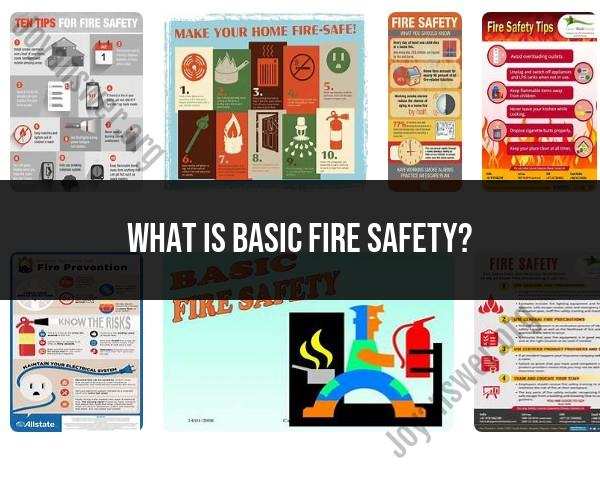What is basic fire safety?
Basic fire safety refers to the fundamental principles, practices, and measures put in place to prevent, detect, and respond to fires. It encompasses a range of strategies and actions designed to protect people, property, and the environment from the destructive effects of fires. Basic fire safety is crucial in various settings, including homes, workplaces, schools, and public spaces. Here are some fundamental aspects of basic fire safety:
1. Fire Prevention:
Hazard Identification: Identify and eliminate or control potential fire hazards. This includes proper storage of flammable materials, ensuring electrical safety, and minimizing fire risks.
Smoking Safety: If smoking is allowed, provide designated smoking areas and emphasize proper disposal of cigarette butts.
Housekeeping: Maintain a clean and organized environment. Clutter can contribute to the rapid spread of fire.
Appliance Safety: Regularly inspect and maintain appliances. Turn off appliances when not in use, and avoid overloading electrical circuits.
Cooking Safety: Practice safe cooking habits, such as never leaving cooking unattended and keeping flammable items away from heat sources.
2. Fire Detection:
Smoke Alarms: Install smoke alarms in key areas of buildings, including bedrooms and hallways. Test alarms regularly and replace batteries as needed.
Fire Detection Systems: In commercial and industrial settings, use advanced fire detection systems, such as fire alarms and sprinkler systems.
3. Emergency Planning:
Evacuation Plans: Develop and regularly review evacuation plans for buildings. Ensure that occupants know escape routes and assembly points.
Emergency Exits: Keep emergency exits clear and easily accessible. Exit doors should be well-marked and equipped with panic hardware.
Fire Drills: Conduct regular fire drills to familiarize occupants with emergency procedures. Practice evacuation routes and assembly point locations.
4. Firefighting Equipment:
Fire Extinguishers: Install appropriate fire extinguishers in easily accessible locations. Train personnel on how to use extinguishers for small fires.
Fire Hoses and Hydrants: In larger buildings, ensure the availability and proper maintenance of fire hoses and hydrants.
5. Training and Education:
Fire Safety Training: Provide fire safety training to occupants, employees, and relevant personnel. This training should cover evacuation procedures, the use of firefighting equipment, and general fire safety awareness.
Awareness Programs: Conduct awareness programs to educate individuals about fire safety practices, potential hazards, and the importance of prevention.
6. Emergency Response:
Emergency Services Coordination: Establish communication and coordination with local emergency services. Provide clear information about the location and nature of the emergency.
First Aid Training: Ensure that designated personnel are trained in basic first aid to address injuries that may occur during a fire emergency.
7. Fire Safety Regulations:
Compliance: Adhere to local, state, and national fire safety regulations. Ensure that buildings and facilities meet applicable codes and standards.
Inspections: Conduct regular inspections of fire safety equipment, emergency exits, and other safety features to ensure compliance and functionality.
8. Fire Safety Equipment Maintenance:
Regular Inspections: Regularly inspect and maintain fire safety equipment, including alarms, extinguishers, and sprinkler systems.
Professional Services: Engage qualified professionals for periodic inspections and maintenance of specialized fire safety systems.
9. Communication:
Emergency Communication Systems: Establish effective communication systems for alerting occupants during an emergency. This may include loudspeakers, intercoms, or other notification methods.
Emergency Contacts: Maintain a list of emergency contacts, including local fire departments and other relevant authorities.
Basic fire safety practices are essential for creating a safer environment and minimizing the risk of fire-related incidents. Whether at home, in the workplace, or in public spaces, the implementation of these principles contributes to the overall safety and well-being of individuals and communities.
Basic Fire Safety Measures: Residential and Commercial Differences and Key Elements of a Plan
1. Basic Fire Safety Measures:
Basic fire safety measures are essential to prevent fires and ensure preparedness in case they occur. These measures apply to both residential and commercial settings, though specific practices may differ:
a. Smoke alarms and carbon monoxide detectors:
- Install working smoke alarms on every level of your home, including outside bedrooms, and carbon monoxide detectors near sleeping areas.
- Test smoke and carbon monoxide detectors monthly and replace batteries twice a year.
b. Fire extinguishers:
- Have readily accessible fire extinguishers in kitchens, garages, and other potential fire hazard areas.
- Learn how to properly use fire extinguishers for different types of fires.
c. Electrical safety:
- Avoid overloading electrical outlets and extension cords.
- Use the correct size and type of fuse or circuit breaker for each electrical circuit.
- Do not run electrical cords under carpets or rugs.
- Have a qualified electrician inspect and repair any faulty electrical wiring.
d. Flammable materials:
- Store flammable materials, such as gasoline, paints, and solvents, in properly labeled containers in a cool, well-ventilated area away from heat sources.
- Dispose of oily rags and other materials that can spontaneously combust safely and promptly.
e. Kitchen safety:
- Never leave cooking unattended.
- Keep flammable materials like towels and curtains away from stovetops.
- Turn off appliances and cooking equipment when not in use.
f. Smoking:
- Smoke only in designated areas and never smoke in bed.
- Properly dispose of cigarette butts and lighters.
2. Residential vs. Commercial Differences:
While basic fire safety principles are common, some practices differ between residential and commercial settings:
a. Evacuation plans:
- Residential buildings typically require personal evacuation plans for families.
- Commercial buildings need comprehensive evacuation plans designed for large numbers of occupants and specific fire hazards.
b. Fire drills:
- Residential fire drills are often informal and spontaneous, focusing on family escape routes.
- Commercial fire drills are mandatory and conducted regularly, involving all occupants and simulating different fire scenarios.
c. Fire alarm systems:
- Residential buildings may have interconnected smoke alarms or simple fire alarm systems.
- Commercial buildings require complex fire alarm systems connected to a central monitoring station, capable of alerting authorities and activating sprinklers.
d. Emergency response:
- Residents are primarily responsible for responding to fires in their homes.
- Commercial buildings often have designated fire wardens trained to use fire extinguishers and guide occupants during evacuation.
3. Basic Fire Safety Plan Elements:
Every home and business should have a basic fire safety plan outlining steps to take in case of a fire:
a. Escape routes:
- Identify multiple escape routes from each room of the building.
- Ensure escape routes are clear of obstacles and easy to access.
- Designate a meeting place outside the building where everyone will gather after evacuation.
b. Communication plan:
- Establish a communication plan for family members or employees to stay informed and accounted for during an emergency.
- Identify a central contact person to call for assistance.
c. Fire extinguisher training:
- Ensure everyone in the building knows how to use a fire extinguisher properly.
- Conduct regular training sessions and practice drills to refresh knowledge and skills.
d. Emergency procedures:
- Outline procedures for reporting a fire to emergency services immediately.
- Train individuals on how to activate fire alarm systems and extinguish small fires safely.
- Establish procedures for assisting individuals with disabilities during evacuation.
e. Plan review and update:
- Regularly review and update the fire safety plan to reflect changes in the building or occupants' needs.
- Conduct drills periodically to assess the plan's effectiveness and identify areas for improvement.
Remember, implementing these basic fire safety measures and having a well-defined plan can significantly increase safety and reduce the risk of fire-related injuries and property damage.













